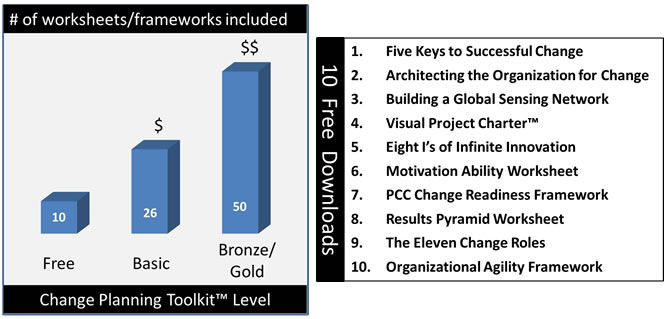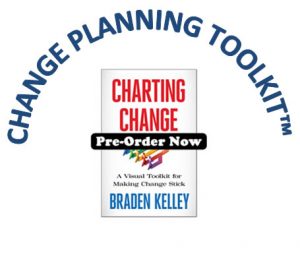 The Change Planning Toolkit™ is finally here!
The Change Planning Toolkit™ is finally here!
Following the success of Stoking Your Innovation Bonfire, it has become abundantly clear in my work with clients that for any organization to be good at innovation they must be good at change.
Not surprisingly, research shows that 70% of change efforts fail. There are many reasons why, including that many people find the planning of a change effort overwhelming and lack tools for making the process more visual, collaborative and human.
Putting my two decades of research together with my project management and change leadership experience with clients, I have distilled key insights into the Human-Centered Change™ methodology and captured it in a new book Charting Change (Feb 2016) and a suite of tools to help get everyone literally on the same page for change.
 I am making 10 Free Human-Centered Change™ Tools from the toolkit available as 11″x17″ samples, I am making 10 Free Human-Centered Change™ Tools from the toolkit available as 11″x17″ samples, |
 but book buyers will get access to the Change Planning Toolkit™ Basic License (26 of 50+ tools) at 11″x17″ size — a $500 value, but book buyers will get access to the Change Planning Toolkit™ Basic License (26 of 50+ tools) at 11″x17″ size — a $500 value, |
 and buyers of the Change Planning Toolkit™ Bronze License will get access to all 50+ tools for individual educational use at an 11″x17″ size — a $1,200 value. and buyers of the Change Planning Toolkit™ Bronze License will get access to all 50+ tools for individual educational use at an 11″x17″ size — a $1,200 value. |
 Site licenses are available for professional or commercial use starting at $2/yr per employee*, and include access to poster size versions of many of the tools (35″x56″), along with public or private training sessions. Click here for more information and pricing.
Site licenses are available for professional or commercial use starting at $2/yr per employee*, and include access to poster size versions of many of the tools (35″x56″), along with public or private training sessions. Click here for more information and pricing.
I am very excited to share with you the Change Planning Toolkit™, including the popular Visual Project Charter™, Change Planning Canvas™ and many other great tools for increasing your change success!
Increase your consulting revenue or your organizational agility and get a jump on your competition!
Click here to access the Human-Centered Change™ tools
*Bronze Site Licenses have a one-time setup fee of $299. Site License fee based on total number of employees in the organization.
Below you’ll find a downloadable presentation that gives you five reasons to invest in the Change Planning Toolkit™ in case you need help convincing your boss to let you make the nominal expenditure or to fund a site license or private event to train you and your team and trainers.
![]() Sign up here to get Human-Centered Change & Innovation Weekly delivered to your inbox every week.
Sign up here to get Human-Centered Change & Innovation Weekly delivered to your inbox every week.
The Five Keys to Successful Change
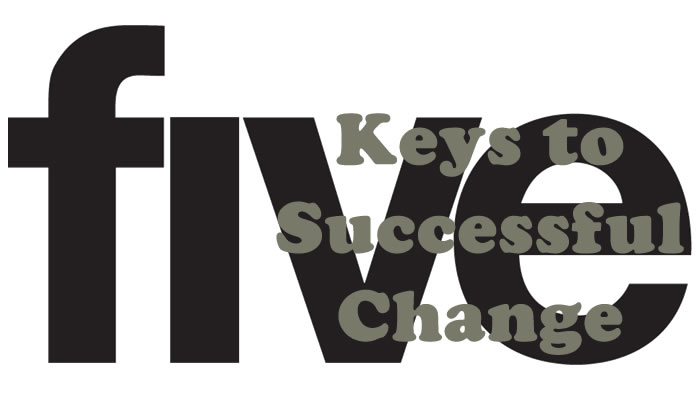
by Braden Kelley
My next book, Charting Change, is a followup to Stoking Your Innovation Bonfire and is now available for pre-order. While my first book helped people identify and remove barriers to innovation, my next book is designed to make the process of planning change efforts less overwhelming and more human.
Charting Change will introduce a visual, collaborative Human-Centered Change™ methodology designed to help get everyone literally all on the same page for change.
The toolkit begins by painting a different background for the landscape of organizational change. Here we introduce the first of more than fifty tools and frameworks comprising that make up the Human-Centered Change™ methodology.
When it comes to organizational change, most people focus on change management and there is even a couple of professional associations organized around the practice of change management, including the Association of Change Management Professionals (ACMP).
But change management is only one of the Five Keys to Successful Change:

Leave one out and eventually your change effort, no matter how big or small, will eventually fail. If you’re setting setting out to change the world, even a small corner of it, then you’ll want to be sure to consider each of the five keys and make sure that you proceed in a measured way that takes each into account.
Let’s look at each briefly in turn before we look at each area in more detail in future posts, and eventually in my new book in February 2016.
The Five Keys to Successful Change
1. Change Planning
Change Planning is the first key to successful organizational change, and it focuses on drawing out the key issues of the necessary change and puts some structure and timeline around them. You will find you have a better experience and a more successful outcome if you use a more visual, collaborative method using something like the Human-Centered Change™ methodology I will be releasing soon to help you create the necessary change plans, goals, metrics, etc.
2. Change Leadership
Change Leadership is the second key to successful organizational change, and is important because good change leadership provides the sponsorship, support and oversight necessary for the change activities to receive the visibility, care, and attention they need to overcome inertia and maintain momentum throughout the process of transformation.
3. Change Management
Change Management represents the third key to successful organizational change, and it is probably the one most people think of when they think about organizational change because it focuses on managing the change activities necessary to achieve the change objectives. The term itself has some challenges however as the term also refers to the management of code changes during the software development process and its relationship with project management is confused. We will dig more into the relationship between project management and change management in a future article.
4. Change Maintenance
Change Maintenance represents the fourth and probably most neglected key to successful organizational change. Many change leaders lose interest after the major launch milestones are achieved, and this is a real risk to sustained success of the change effort. During the change maintenance phase is when you measure the outcomes of the planned change activities and reinforce the change, to make sure the change effort has met the change objectives and when you ensure that the behavior change becomes a permanent one. Neglect this phase and people often slip back into their old, well worn patterns of behavior.
5. Change Portfolio Management
Every organization will have a broad collection of larger change efforts (digital transformation, merger integration, layoffs, etc.) and smaller change efforts (including all projects) underway or in the planning or maintenance stages at all times. This portfolio of change efforts must be managed and Change Portfolio Management represents the necessary activities for balancing all of the resource needs of this variety of change efforts.
Conclusion
This is the first step in the Human-Centered Change™ approach to organizational change that you can use to help change the world in the series of Big C and Little C change efforts that you may lead throughout your life. Big C change efforts are what most people think as change initiatives (mergers and acquisitions, layoffs, transformations, etc.) while Little C change efforts are any project that you might undertake (after all every project changes something).
If we want to do better than the 70% failure rate that change practitioners face in their work, we must look beyond change management or change leadership, and instead think more holistically about change, and to consider all Five Keys to Successful Change.
I hope you have found the article and the framework a useful first building block as we work together to build a strong foundation for successful organizational change. To be alerted when the Human-Centered Change™ methodology becomes available, please be sure and click the link below to join the mailing list, and stay tuned for the next article in this series!
Click to access this framework as a scalable 11″x17″ PDF download
![]() Sign up here to get Human-Centered Change & Innovation Weekly delivered to your inbox every week.
Sign up here to get Human-Centered Change & Innovation Weekly delivered to your inbox every week.
Change the World – Step One
 Do you want to change the world?
Do you want to change the world?
Even just one tiny corner of your own world?
Change often feels overwhelming, scary even, and frequently we don’t know where to begin.
Stoking Your Innovation Bonfire focused on helping organizations identify and remove barriers to innovation, and has also served as a great innovation primer for innovation practitioners all over the world.
As people choose and commit to going down the innovation path in a measured way, one of the first things they discover is that many things will have to change inside the organization and in how the entity engages with others outside the organization for their new product or service ideas to successfully walk the transitional path from insight to idea to experiment to implementation project to market offering and market success.
Because of this, my next book and most of my future articles here on Innovation Excellence in the run up to the release of my Change Planning Toolkit™ will be focused on helping people build a strong foundation for achieving successful organizational change. This series of articles will culminate with the launch of a new book from Palgrave Macmillan in January 2016 on the best practices and next practices of organizational change and an introduction to my Change Planning Toolkit™.
So, if we’re hoping to change the world, our world, whether that is with a big W or a little one, where should we begin?
Let’s begin by painting a background for the landscape of organizational change.
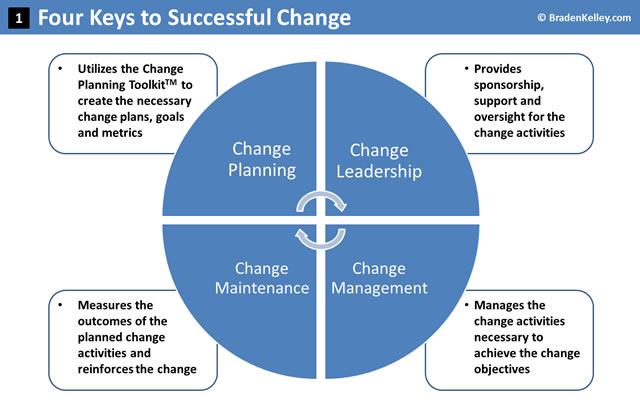
Above you’ll see a visualization of the Four Keys to Successful Change. Leave one out and eventually your change effort, no matter how big or small, will eventually fail. If you’re setting setting out to change the world, even a small corner of it, then you’ll want to be sure to consider each of the four keys and make sure that you proceed in a measured way that takes each into account.
Let’s look at each briefly in turn before we look at each area in more detail in future posts, and eventually in the book in January 2016.
The Four Keys to Successful Change
1. Change Planning
Change Planning is the first key to successful organizational change, and it focuses on drawing out the key issues of the necessary change and puts some structure and timeline around them. You will find you have a better experience and a more successful outcome if you use a more visual, collaborative method using something like the Change Planning Toolkit™ I will be releasing soon to help you create the necessary change plans, goals, metrics, etc.
2. Change Leadership
Change Leadership is the second key to successful organizational change, and is important because good change leadership provides the sponsorship, support and oversight necessary for the change activities to receive the visibility, care, and attention they need to overcome inertia and maintain momentum throughout the process of transformation.
3. Change Management
Change Management represents the third key to successful organizational change, and it is probably the one most people think of when they think about organizational change because it focuses on managing the change activities necessary to achieve the change objectives. The term itself has some challenges however as the term also refers to the management of code changes during the software development process and its relationship with project management is confused. We will dig more into the relationship between project management and change management in a future article.
4. Change Maintenance
Change Maintenance represents the fourth and probably most neglected key to successful organizational change. Many change leaders lose interest after the major launch milestones are achieved, and this is a real risk to sustained success of the change effort. During the change maintenance phase is when you measure the outcomes of the planned change activities and reinforce the change, to make sure the change effort has met the change objectives and when you ensure that the behavior change becomes a permanent one. Neglect this phase and people often slip back into their old, well worn patterns of behavior.
Conclusion
This is the first article in a series to help make changing the world seem a little less overwhelming, a little less scary. I hope you have found the article and the framework a useful first building block as we work together to build a strong foundation for successful organizational change. To be alerted when the Change Planning Toolkit™ becomes available, please be sure and click the link below to join the mailing list, and stay tuned for the next article in this series!
Sign up for updates on the Change Planning Toolkit™ (Charting Change Insiders)
Image credit: Youthventure.org

![]() Sign up here to get Human-Centered Change & Innovation Weekly delivered to your inbox every week.
Sign up here to get Human-Centered Change & Innovation Weekly delivered to your inbox every week.
Your Chance to Help Change Change
 My first book Stoking Your Innovation Bonfire was designed to help organizations identify and remove barriers to innovation, but readers also found it to be a great primer on how to take a structured, sustainable approach to innovation, and as a result the book has found its way into university courses and libraries around the world.
My first book Stoking Your Innovation Bonfire was designed to help organizations identify and remove barriers to innovation, but readers also found it to be a great primer on how to take a structured, sustainable approach to innovation, and as a result the book has found its way into university courses and libraries around the world.
I’ve been thinking over the last few years about where I could provide the most value in a follow-up book, and it came to me that innovation is really all about change and that where most organizations fail to achieve innovation is in successfully making all of the changes necessary to transform their inventions into innovations. At the same time, the world has changed, the pace of change is accelerating and organizations are struggling to cope with the speed of changes required of them, including the digital transformation they need to make.
So, my next book, this time for Palgrave Macmillan, will focus on highlighting the best practices and next practices of organizational change. And where does any successful change effort begin?
With good planning. But it is really hard for most people to successfully plan a change effort, because it is hard to visualize everything that needs to be considered and everything that needs to be done to affect the changes necessary to support an innovation, a digital transformation effort, a merger integration, or any other kind of needed organizational change.
But my Change Planning Toolkit™ and my new book (January 2016) are being designed to help you get everyone literally all on the same page for change. Both the book and my collaborative, visual Change Planning Toolkit™ are nearly complete. But before they are, I’d like to engage you, the intelligent, insightful Innovation Change Management community to help contribute your wisdom and experience to the book.
I’m looking for a few change management tips and quotes attributable to you (not someone else) to include in the book along with the other best practices and next practices of organizational change that I’ve collected and the introduction to my Change Planning Toolkit™ that I’m preparing.
It’s super simple to contribute. Just fill out the form, and the best contributions will make it into the book or into a series of articles that I’ll publish here and on a new site focused on organizational change that I’m about ready to launch.
I look forward to seeing your great organizational change quotes and tips!
UPDATE: The book is now out! Grab a copy here:

![]() Sign up here to get Human-Centered Change & Innovation Weekly delivered to your inbox every week.
Sign up here to get Human-Centered Change & Innovation Weekly delivered to your inbox every week.
Now Available in Swedish – Nine Innovation Roles Cards
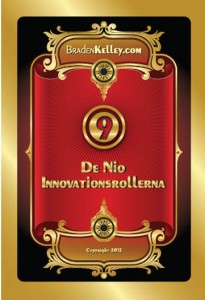 I am proud to announce the Swedish language design of my Nine Innovation Roles card deck, made possible by the translation efforts of Aseem Svedberg from Sweden.
I am proud to announce the Swedish language design of my Nine Innovation Roles card deck, made possible by the translation efforts of Aseem Svedberg from Sweden.
Swedish speakers can read more about the Nine Innovation Roles in Swedish thanks to Aseem as well.
I am also excited that I have potential volunteers to translate this information for you in French and Modern Standard Arabic (so stay tuned).
Swedish joins Spanish to become the second non-English translation for the Nine Innovation Roles.
If you facilitate workshops and training sessions, you too can get a valuable new tool for your toolbox and help to take the Nine Innovation Roles global at the same time.
For interested service providers, there are only a few small requirements for becoming a Nine Innovation Roles training partner:
- Translate this page on my site (see Swedish example) – will publish and give translation credit with 1-2 links to first translator of each language
- Translate this article on Innovation Excellence – will publish and give translation credit with 1-2 links to first translator of each language
- #1 and #2 will allow me to get a translated version of the Nine Innovation Roles cards design created for you
- Translate the Nine Innovation Roles presentation embedded in #1 (can leverage #1)
- Translate the Nine Innovation Roles worksheet I link to in #1 (can leverage #1)
- Attend an inexpensive Nine Innovation Roles train the trainer session that I will be holding soon.
To register your interest in becoming a Nine Innovation Roles training partner please fill out the contact form and make a note in the question field.

![]() Sign up here to get Human-Centered Change & Innovation Weekly delivered to your inbox every week.
Sign up here to get Human-Centered Change & Innovation Weekly delivered to your inbox every week.
Now Available in Spanish – Nine Innovation Roles Cards
 I am proud to announce the Spanish language design of my Nine Innovation Roles card deck, made possible by the translation efforts of Vanessa López De la O from Mexico.
I am proud to announce the Spanish language design of my Nine Innovation Roles card deck, made possible by the translation efforts of Vanessa López De la O from Mexico.
Spanish speakers can read more about the Nine Innovation Roles in Spanish thanks to Vanessa as well.
I am also excited that I have potential volunteers to translate this information for you in French and Modern Standard Arabic (so stay tuned).
For other interested service providers, there are only a few small requirements for becoming a Nine Innovation Roles training partner:
- Translate this page on my site (see Spanish example) – will publish and give translation credit with 1-2 links to first translator of each language
- #1 will allow me to get a translated version of the Nine Innovation Roles cards design created for you
- Translate the Nine Innovation Roles presentation embedded in #1 (can leverage #1)
- Translate the Nine Innovation Roles worksheet I link to in #1 (can leverage #1)
To register your interest in becoming a Nine Innovation Roles training partner please fill out the contact form and make a note in the question field.

![]() Sign up here to get Human-Centered Change & Innovation Weekly delivered to your inbox every week.
Sign up here to get Human-Centered Change & Innovation Weekly delivered to your inbox every week.
Partners Wanted – Taking Nine Innovation Roles Global
 I was in Boston, MA last week for the Front End of Innovation conference and had the opportunity to train dozens of potential corporate Nine Innovation Roles trainers as part of my quest to set the Nine Innovation Roles free and make this powerful tool available for people to use to improve the effectiveness of their innovation teams and the overall innovation capability of the organization.
I was in Boston, MA last week for the Front End of Innovation conference and had the opportunity to train dozens of potential corporate Nine Innovation Roles trainers as part of my quest to set the Nine Innovation Roles free and make this powerful tool available for people to use to improve the effectiveness of their innovation teams and the overall innovation capability of the organization.
Now it is time for the next step, to train other service providers from all around the world on the Nine Innovation Roles so they can use it with their customers.
Already, we have a Spanish language version of the cards and resources in process.
For interested service providers, there are only a few small requirements for becoming a Nine Innovation Roles training partner:
- Translate this page on my site (see Spanish example) – will publish and give translation credit with 1-2 links to first translator of each language
- Translate this page on my web site – will publish and give translation credit with 1-2 links to first translator of each language
- #1 and #2 will allow me to get a translated version of the Nine Innovation Roles cards design created for you
- Translate the Nine Innovation Roles presentation embedded in #1 (can leverage #1)
- Translate the Nine Innovation Roles worksheet I link to in #1 (can leverage #1)
- Attend an inexpensive Nine Innovation Roles train the trainer webinar that I will be holding soon.
To register your interest in becoming a Nine Innovation Roles training partner please fill out the contact form and make a note in the question field.

![]() Sign up here to get Human-Centered Change & Innovation Weekly delivered to your inbox every week.
Sign up here to get Human-Centered Change & Innovation Weekly delivered to your inbox every week.
Free Nine Innovation Roles Train the Trainer Session
 I will be in Boston, MA this week for the Front End of Innovation conference May 6-8, 2013 at the Seaport World Trade Center, joining 650+ innovation managers and thought leaders from around the world who are serious about learning more about the front-end of innovation or improving existing innovation efforts.
I will be in Boston, MA this week for the Front End of Innovation conference May 6-8, 2013 at the Seaport World Trade Center, joining 650+ innovation managers and thought leaders from around the world who are serious about learning more about the front-end of innovation or improving existing innovation efforts.
For those of you are interested, I am planning to hold a FREE Nine Innovation Roles train the trainer session to go with all of the other FREE Nine Innovation Roles resources I offer hear on my web site under ‘Products’. To register your interest please fill out the contact form and make a note in the question field.
I will also be leading some thought provoking panel sessions, sharing new insights, and reconnecting with innovation friends (both old and new) at this always fun and energizing innovation event.
If you’d like to set up a meeting to explore your innovation efforts or needs while I’m there, please contact me.

![]() Sign up here to get Human-Centered Change & Innovation Weekly delivered to your inbox every week.
Sign up here to get Human-Centered Change & Innovation Weekly delivered to your inbox every week.
Latest Radio Interview with The Health Maven
 I’m proud to share with you the link to my latest radio interview. This time I had the opportunity to sit down and chat with LeAnna J. Carey (@LeannaJCarey), host of the popular radio program The Health Maven – Innovation Talk.
I’m proud to share with you the link to my latest radio interview. This time I had the opportunity to sit down and chat with LeAnna J. Carey (@LeannaJCarey), host of the popular radio program The Health Maven – Innovation Talk.
We spend the 30 minutes talking about The Nine Innovation Roles and how organizations around the world are increasingly utilizing The Nine Innovation Roles to help them build more effective innovation teams. Curious which ones I think LeAnna fills or that I see myself typically filling?
Tune into the broadcast to find out! 🙂
Click here to listen to a recording of the interview

![]() Sign up here to get Human-Centered Change & Innovation Weekly delivered to your inbox every week.
Sign up here to get Human-Centered Change & Innovation Weekly delivered to your inbox every week.
Social Media is the Glue of Innovation
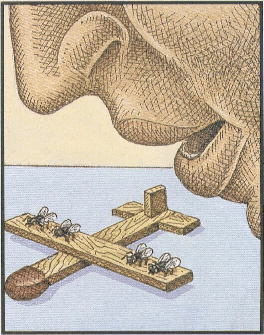 Social media serves an incredibly important role in innovation. Social media functions as the glue to stick together incomplete knowledge, incomplete ideas, incomplete teams, and incomplete skillsets. Social media is not some mysterious magic box. Ultimately it is a tool that serves to connect people and information.
Social media serves an incredibly important role in innovation. Social media functions as the glue to stick together incomplete knowledge, incomplete ideas, incomplete teams, and incomplete skillsets. Social media is not some mysterious magic box. Ultimately it is a tool that serves to connect people and information.
I’m reminded of a set of lyrics from U2’s “The Fly”:
“Every artist is a cannibal, every poet is a thief
All kill their inspiration and sing about their grief”
Social media can help ideas grow and thrive that would otherwise wither and die under the boot of the perfectionist in all of us.
Do you remember the saying “it takes a village to raise a child”? Well, it takes a village to create an innovation from an idea as well, and social media helps to aggregate and mobilize the people and knowledge necessary to do just that.
But, that is social media working in the positive. We must remember that social media tools are just that – tools.
Just as easily as social media tools can be an accelerator for innovation, they can also be an inhibitor – if the participants or the presenters manage to make the less active majority feel that innovation is not something for them.
If you don’t want to be a fool with a tool, then you must be careful to make sure that the social media tools in your organization are fulfilling their role in a positive way and leveraging existing knowledge management and collaboration toolsets:
- To make innovative ideas visible and accessible
- To allow people to have conversations
- To build community
- To facilitate information exchange
- To enable knowledge sharing
- To assist with expert location
- To power collaboration on idea evolution
- To help people educate themselves
- To connect people to others who share their passion
- To surface the insights and strategy that people should be building ideas from
The better you become at the above, the stronger your organization’s innovation capability will become, the more engaged your employees will become, and the more ready you will become to engage successfully in open innovation.
For the most part, what I’ve been talking about is the role of social media in innovation inside the organization. When you leverage social media for innovation outside the organization, it gets a whole lot more complicated.
But, maybe that’s a conversation for another day.
In the meantime, please consider the ways in which social media in your organization might be able to strengthen inter-disciplinary cooperation, make the organization itself more adaptable, and how it could help to create an organization with the power to transform more ideas into innovations.
You might also enjoy these four FREE white papers:
- Effective Conversational Marketing
- Rise of the Social Business Architect
- Harnessing the Global Talent Pool to Accelerate Innovation
- Broadcasting the Voice of the Customer
![]() Sign up here to get Human-Centered Change & Innovation Weekly delivered to your inbox every week.
Sign up here to get Human-Centered Change & Innovation Weekly delivered to your inbox every week.
